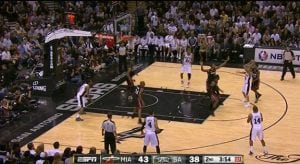 Continuing in our series of floor space and time, today we’ll discuss simple concepts and fundamentals that really are at the heart of how good players and good teams acquire space in effective offenses. Granted, none are revolutionary in and of themselves but, when lumped together, they should serve as reminders to coaches at all levels that any offensive system, set or play would be far more effective if they provided their players the structure and practice time to master the following skills.
Continuing in our series of floor space and time, today we’ll discuss simple concepts and fundamentals that really are at the heart of how good players and good teams acquire space in effective offenses. Granted, none are revolutionary in and of themselves but, when lumped together, they should serve as reminders to coaches at all levels that any offensive system, set or play would be far more effective if they provided their players the structure and practice time to master the following skills.
As for ball handling, it’s generally understood that the essence of acquiring space off the bounce is to create separation. Let’s examine common methods to do so:
- SPEED WITH THE BALL – If one watches play at the youngest levels, inevitably there are players who separate from defenders with pure speed. As players go up the ladder, this method gets more and more difficult but even in the NBA, players blow by defenders with just old fashioned north-south speed. One is reminded of Coach John Wooden’s dictum, “Be quick, but don’t hurry.” Another phrase that comes to mind is, “Play as fast as possible under control.” At the very least, speed with the ball sets up the next two maneuvers and players should strive to have the fastest speed possible as a staple.
- CHANGE OF PACE AND DIRECTION – No matter how fast a player can go with the ball, eventually all ball handlers have to use changes of pace and direction to gain separation. Changing direction alone by crossover, behind-the-back, between-the-legs and roll dribbles is the bare minimum; these tools need to be coupled with changes of pace so that the defender is “on the defensive” because there is variation in direction and speed.
- LEVERAGE – Just as a post-up player uses height, length, girth and strength to leverage a defender, the dribbler can use these same physical attributes to leverage the defender. Once a pocket of space is earned, the ball handler should at least be able to “seal” the defender in much the same manner as a posting player.
- FENDING – Legal or not, the best players use their off arm in subtle ways to create space off the bounce as well as on shots. It’s an art unto itself and not to have it as a weapon in an arsenal is a serious drawback.
- FREEZING THE DEFENDER – A relatively modern phenomenon in half-court isolation where the offensive player (think James Harden) utilizes any and all of his ball handling repertoire in isolation in one spot until the defender “buys” something and gets off balance one way or another. The offensive player then reacts to the opening. Most coaches at most levels aren’t going to teach or encourage this tactic. But, players everywhere practice it on their own.
As for passing, there are several tried and true tactics that help players acquire space and time. Again, let’s examine these methods of creating another type of separation:
- HEAD MAN THE BALL – Borrowed from the hockey terminology, “head man the puck”, in its simplest form means pass the ball to an open player ahead. Implicit in this thought are the fundamentals of “hit the open man” and “don’t hold the ball”. An old-school concept that flies in face of screen-roll, dribble drive and isolation offense, head-manning the ball puts great pressure on the defense before it can get set.
- PASS FAKES – A very useful tool especially when trying to feed a post-up player, get out of trouble or against zones. A good fake creates the space to make an effective pass.
- SHOT FAKES – Any catch and shoot or triple threat player needs this weapon to get space to shoot, pass or drive. The shot fake never goes out of style. Defenders are suckers for it.
- SKIP PASSES – At one time skip passes were thought to be a weapon one used only against zones to acquire twice the space of the normal 15’-18’ pass. With the evolution into modern dribble-drive and space oriented offenses, skip passes are now utilized off the drive against man defense gaps.
Coaches and players alike need a complete understanding that as the level of play gets higher, the pockets or gaps shrink accordingly. Having a highly developed ball handling and passing skill set can only help a player excel, let alone stay competitive as they climb the ladder.


